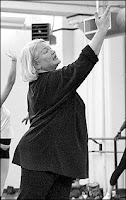 |
| Xiomara Reyes and Jose Carreno photo Ottawa Citizen |
So, I’m cobbling together the two performances by the same dancers in the roles of Giselle, Count Albrecht, Hilarion, Wilfred and Berthe (with different Bathildes, different Myrtas), with the same conductor, Ormsby Wilkins.
Having seen the first two performances and with a ticket for only one more, I was aching to see Veronika Part, but was willing to forgo the experience until I spoke to Isabella Boylston after Friday evening’s performance. She told me she was dancing the Peasant pas de deux Saturday evening, so that clinched it.
I was going to land a ticket if I had to rent a wheelchair and obtain wheelchair seating in order the see the show! Fortunately, Saturday morning there were still a few seats left (by evening the theatre was completely sold out) and I bought a 3rd row seat in the middle of what is essentially the second tier of the theatre (there are 3 tiers above the orchestra).
I was happy I did, for Saturday night’s presentation had so many wonderful moments, the best being Isabella’s sparkling debut in the peasant PDD.
Xiomara Reyes is eternally youthful and the spring in her jump is amazing. She won our hearts immediately as she vaulted onto the stage and performed her introductory circle of ballonées.
I am not alone in saying that, when given a choice of which dancer to see in a role, Xiomara is not my first, or even my second or third choice. Therefore, it is a pleasant surprise to enjoy her interpretation of a major role when I am watching her.
Conditioned to think she will display every emotion with a wide grin, it is refreshing to see that she does indeed have a more extensive vocabulary of expression.
While her dévelopés a la seconde do not stun with ear-scratching reach like those of, say, Svetlana Zakharova (whose Giselle I never want to see), or Maria Riccetto’s, even, I honor their purity. (I’m quite sure today’s rising young ballet stars who crave the athleticism of their current ballet idols would give Xiomara a big thumbs-down.)
Partnered with the reliable Jose Carreno, Reyes confidently carried out all of Giselle’s choreography and pathos as if she’s been doing it forever.….oh, wait.
Still, there were standout moments.
Memorable Reyes moment: Giselle’s famous Act II penché was elegantly developed in a molasses-slow rise of the cantilevered outer leg supported by the slow descent of a well-held upper body. Xiomara was so solid nothing could throw her off this tricky balance. It was one of the gems of her portrayal.
Especially nice to see was the opening Giselle/Loys dance culminating in high, forward-moving jetés, back legs in attitude, done perfectly in unison with lovely abandon. In fact, together the two are a well-suited pair, in height, ethnicity (it does count – ballet is, after all, visual art), perhaps in training?
They move as one and relate naturally. It is so easy to picture them as a couple and quite impossible to believe the same of Carreno with either of his Bathildes: Luciana Paris (with whom he dances a sensual Sinatra Suite -- but that's another ballet) or Kristi Boone.
Jose Carreno, he of swash-buckling virility and balletic classicism, was an endearing Count and an actor of experience, who, nevertheless, has a more modest arsenal of communicative gestures and facial expressions than befits the role.
He goes through the emotive paces – petal-discarding to assuage Giselle after her ominous plucking, hand to hip to draw the sword that isn’t there (although he provided the nice touch of lingering there, perhaps to cover for his mistake or to press his flesh in rebuke for slipping), forearm-to-forearm grip with the Prince of Courland to acknowledge their relationship – but somehow isn’t all that he could be.
He is also showing his age in demanding jumps, landing with a thump followed by a laden leg-lift into plié arabesque rather than displaying the easy elevation of his younger co-Counts who rebound with a light, straight upward throw of the arabesque leg.
I still love watching him. He is an irresistible lover of the sweet and safe variety. Of the three Counts who placed their fingers under Giselle’s chin to tilt it upward, his was the touch I wanted to feel myself. His expression so tender as he gazed into Giselle’s eyes while lifting her head, the look of love in his eyes so affectionate, would make any woman melt. Here’s an instance where his minimalism had intense impact.
Reyes portrayed Giselle securely -- delicately when called for, insanely with fitting intensity in the mad scene, with steely determination fighting for her Count’s life in Act II -- and, being the ballerina she is, this is enough for the average audience.
But when you watch ballet all the time, in person and on video, and are privileged to see dazzling moments amongst the regular ones, you kind of want to be surprised at each performance with something that's special from the principal dancers.
Often, those moments come from a soloist or a corps de ballet member given a lead role, even a small one. But it’s normal to expect to see the top of the heap dancers do something unforgettable.
It didn’t occur with either of the Reyes/Carreno attempts. I don’t want to sell them short, for they are formidable principals both, but this is American Ballet Theater.
A triple-A rating for Carlos Lopez, Count Carreno’s Wilfred: Attentive, attractive, accomplished. More about Lopez when I discuss his peasant pas de deux.
A few words about Susan Jones’s Berthe: wonderful, skillful miming.
ABT ballet master Jones, diminutive and quite round in Berthe’s bulky costume, was in supreme command of her stage business and a no-nonsense mother to Giselle.Plaudits to her for the watchful heed of her daughter, her village-mother hen manner of keeping Giselle’s friends in check, and her emphatic shooing away of the peccant Count from Giselle’s body.
Gennadi Saveliev, another dancer whom I don’t elect to see when there are other choices (I don’t know why – perhaps it’s just my thirst for someone newer), danced and acted Hilarion to perfection.
Here’s a country boy who’s all guts and no glory. His is a love so deep that he was probably relieved to be danced to death in hopes it would reunite him with his beloved Giselle.
Memorable Gennadi moments:
1. Act I: As he rushes to the expired Giselle’s side after the Count has been ousted from it, he not only kneels, removing his cap and pressing it to his chest (as all our Hilarions do), but he grabs Giselle’s leg and holds onto it tightly as his final and very poignant physical contact with the true love he has lost.
2. Act II: His Hilarion tying the cross together methodically and with great care demonstrates that this young man knows his way around knots and constructing things from branches. With each overlay and tightening of the rope, his anguish is palpable. He drives the cross into the soil of Giselle’s grave with finality, stepping back to check its security, and feeling the gravity of the moment.
3. Sensing the Wilis imminent invasion of the clearing, his spinning chainés are more a plaintive act of “take me” rather than the result of an unstoppable force against which he tries to fight.
Luciana Paris’s Bathilde (Thursday evening) was exceedingly striking in appearance and her stride across stage was like a swan skimming the surface of a lake. She performed her role very, very well, and decided to use rage as the manifestation of her anger. It made for great contrast. Carreno’s Count was not one to exhibit fiery temper. Bathilde would have been the matriarch in their union.
Kristi Boone’s Bathilde (Saturday evening) was regal and divine. She was every inch the noblewoman, but a benevolent one, who unclasped her gold necklace from her own neck (after consultation with her father) and fondly reclasped it around Giselle’s. Albrecht, when caught in his lie, acquiesced to her admonitions, but did not really seem to belong with her.
All Myrtas, Moynas, Zulmas, and Peasant pas de deux will be discussed in posts dedicated only to them.














No comments:
Post a Comment